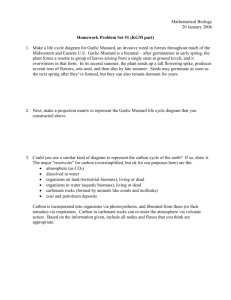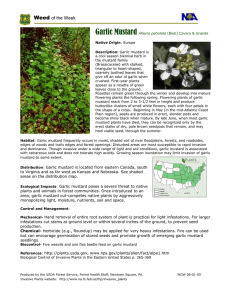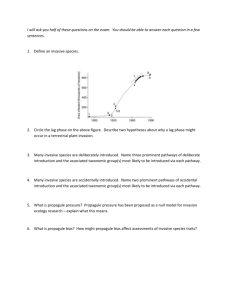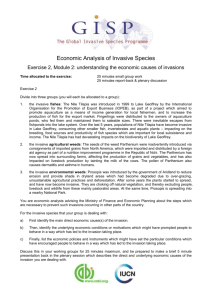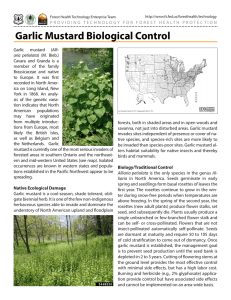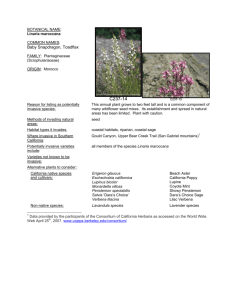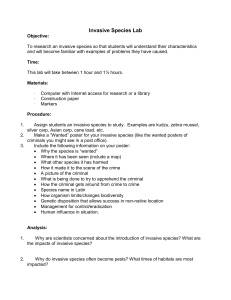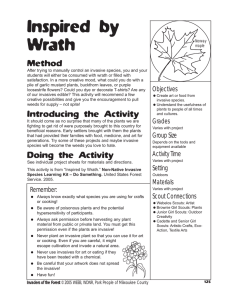Invasion, Biodiversity, and Conservation: What Are
advertisement
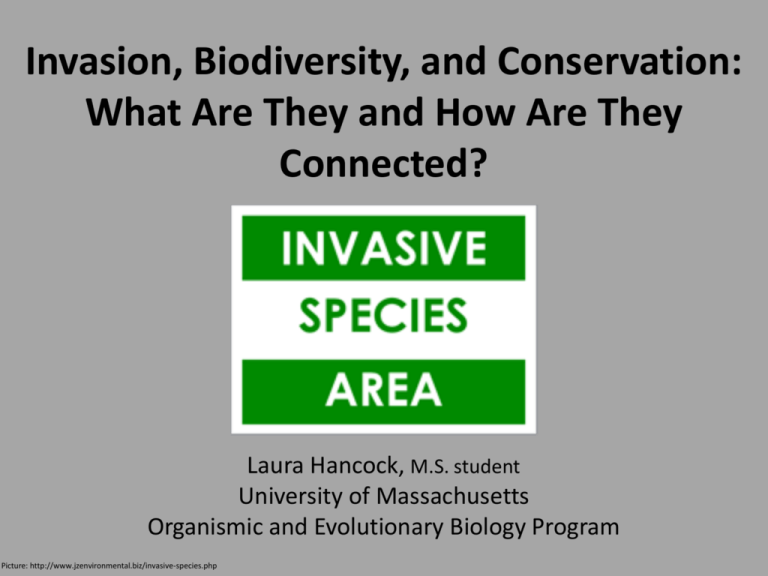
Invasion, Biodiversity, and Conservation: What Are They and How Are They Connected? Laura Hancock, M.S. student University of Massachusetts Organismic and Evolutionary Biology Program Picture: http://www.jzenvironmental.biz/invasive-species.php Overview 1. 2. 3. 4. 5. 6. Photo: Peter Muka Invasion Stinson Lab Research Biodiversity Conservation Connecting these ideas How you can get involved Invasion: What is it? • Native species live in an area where they are found naturally • Species that have been moved by human activities to a location where they don’t naturally occur are exotic species • When an exotic species negatively alters the native communities or causes economic problems it is invasive • https://www.youtube.com/watch?v=J-ftiWffNTc • Not all exotic species are invasive! http://gilbertlake.org/2014/09-25-14-invasive-species.htm Invasion: What About Plants? • Animal invasions make it into the news a lot, but plants matter too! • Its really easy to (accidentally) transport them • Plants “self fertilize” http://ourstoriesandperspectives.com/2012/04/02/new-boot-brush-stations-curb-hitchhiking-seeds/ Invasion Hypotheses • • • • • • Biotic Resistance Hypothesis Propagule pressure Enemy release Novel weapons Polyploidy And many others http://www.slideshare.net/LaurentLamarque/ecology-and-evolution-of-maple-tree-invasion Biotic Resistance Hypothesis • Ecosystems with high biodiversity are more resistant to invasive species than ecosystems with low biodiversity • Low biodiversity = more invasible? http://philschatz.com/biology-concepts-book/contents/m45571.html http://www.slideshare.net/MaraLuarte/low-and-high-biodiversity Propagule Pressure Hypothesis • Propagule = seed • Number of seeds released * number of releasing events • Lots of seeds * lots of events = high propagule pressure Photo: Peter Muka Enemy Release Hypothesis http://bigsciencelittlesummaries.com/can-invaders-become-darwinian-demons/ Novel Weapons Hypothesis • Novel = new • Weapon = defense/ increases competitive ability http://www.theatlantic.com/technology/archive/2012/03/todays-high-tech-archery-isnt-much-like-the-hungergames-version/255041/ Polyploidy • Polyploid = more than two chromosomes • More chromosomes = more variation = can better adapt to new places https://en.wikipedia.org/wiki/Polyploid Is it Invasive?! http://www.invasivespeciesinfo.gov/plants/knotweed_child.shtml http://www.ecocontrol.co.uk/gallery.asp http://northforkwatershed.tripod.com/id6.html Is it Invasive?! YES! Fallopia japonica; Japanese knotweed http://www.newsweek.com/2014/07/11/japanese-knotweed-driving-men-murder-257257.html Is it Invasive!? http://woodyplants.wikidot.com/rhamnus-frangula Is it Invasive!? YES! Rhamnus frangula; glossy buckthorn http://plants.usda.gov/core/profile?symbol=FRAL4 http://plants.usda.gov/core/profile?symbol=FRAL4 Guess the Invasive!? https://extension.umd.edu/hgic/oriental-bittersweet https://gobotany.newenglandwild.org/species/celastrus/scandens/ Guess the Invasive!? Celastrus orbiculatus; Oriental bittersweet https://gobotany.newenglandwild.org/species/celastrus/scandens/ https://extension.umd.edu/hgic/oriental-bittersweet Is it Invasive!? http://en.cvetq.info/news.php?extend.71.15 Is it Invasive!? YES! Rosa multiflora; multiflora rose https://www.minnesotawildflowers.info/tree-shrub/multiflora-rose Is it Invasive?! http://homelandscape.net/norway-maple/ Is it Invasive?! YES! Acer platanoides; Norway Maple http://www.nps.gov/plants/alien/pubs/midatlantic/acpl.htm http://homelandscape.net/norway-maple/ The Stinson Research Lab The main goals in our lab: 1. Identify range expansion mechanisms and changes in a population of garlic musatrd over time -> Me 2. Characterize the disruption of plant-mycorrhizal symbioses by garlic mustard -> Julia + Collaborators 3. Quantify the effects of global change on garlic mustard and its ability to invade -> Me, Julia, Collaborators 4. Identify the best way to eradicate garlic mustard while quickly restoring the native ecosystems Alliaria petiolata; garlic mustard • Invasive herbacious plant in much of the US • Introduced to the US in about 1860 • Prefers “edge” habitats, however.. http://www.eddmaps.org/distribution/uscounty.cfm?sub=3005 More on Garlic Mustard • Biennial plant -> two year growth First year rosettes Photo: Peter Muka Second year adults http://eattheweeds.com/forum/index.php?topic=1231.0 https://extension.umass.edu/landscape/weeds/ alliaria-petiolata Garlic Mustard and Mycorrhizal Fungi • What is arbuscular mycorrhizal fungi (AMF)?? • Garlic mustard doesn’t associate with AMF • Garlic mustard inhibits association between native plants and AMF! http://www.uws.edu.au/hie/research/research_projects/how_plants_benefit_from_par tnerships_with_soil_fungi My research: What is it? I’m trying to figure out: 1. Are the edge and understory sub-populations similar in size? 2. Is garlic mustard able to successfully sustain itself in the forest understory over time? Or is there a source-sink dynamic? 3. Is there a selection for a different ‘type’ of garlic mustard plant? • E.g. smaller, taller, more flowers, more glucosinolates? My research: Methods Forest Understory = Shady Forest Edge = Sunny Forest Understory = Shady Forest Edge = Sunny Forest Edge = Sunny Forest Understory = Shady 3 site * 2 habitats each = 6 plots At each of the 6 plots the number of rosettes and adults were counted Sites were counted in 2003, 2004, 2015 Garlic Mustard: IRL Photo: Peter Muka Photo: Peter Muka My research: Results Another Piece to the Puzzle… • What about Climate change? http://prn.fm/nature-bats-last-10-06-15/ Julia and the SWaN Plots • All plots are at the Harvard Forest, an LTER site • Soil Warming and Nitrogen Plots 1. 2. 3. 4. Control (no change) Warmed Soil Extra Nitrogen Warmed Soil + Extra Nitrogen http://harvardforest.fas.harvard.edu/blog/soil-alive%E2%80%A6%E2%80%A6with-microorganisms Diversity! How do we measure it? • Species Richness (= number of species in a community) • But what about evenness? – It’s a measure of how close each species is in the community • Two main indices: 1. Shannon Index 2. Simpson Index Richness and Evenness Richness = 5 Richness = 5 Diversity & Invasion • Some native species use invasive species as a food source or nesting sites, however.. • Simply adding a species doesn’t mean more diversity • Video! https://www.youtube.com/watch?v=JftiWffNTc Connecting Invasion, Biodiversity, and Conservation • What do we conserve? • Conservation is already hard to do • Think back to Invasion hypotheses and ecological interactions http://iccopywriting.com/conservation-is-key/ Get involved • Go Botany; gobotany.newenglandwild.org • TIPS Network; tipsenemies.com
